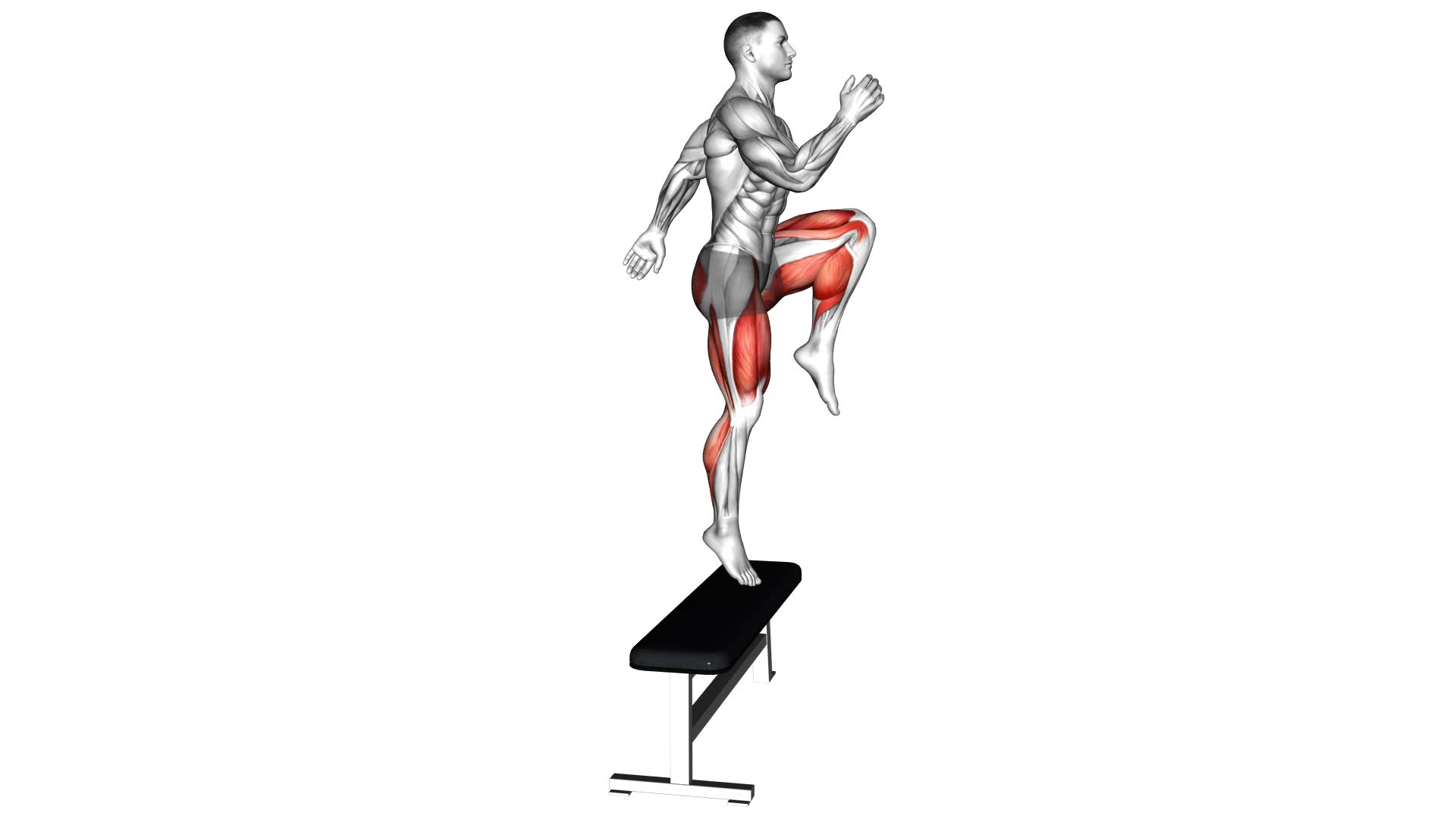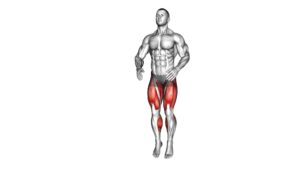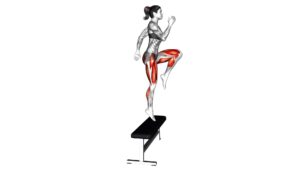Jump Step-Up (male) – Video Exercise Guide & Tips

Are you looking for an effective lower body workout? Look no further than the jump step-up! This exercise targets your legs and glutes while also improving your balance and coordination.
Watch This Exercise Video
In this video exercise guide, we'll show you the proper form and technique for the jump step-up, as well as variations to increase the intensity. Avoid common mistakes and learn how to incorporate this exercise into your workout routine for maximum results.
Let's get jumping!
Key Takeaways
- The Jump Step-Up is a beneficial exercise for improving lower body strength and cardiovascular endurance.
- It targets multiple muscle groups including the quadriceps, hamstrings, glutes, and calves.
- Proper form and technique are important, including maintaining controlled and fluid motion throughout the movement.
- To increase the intensity, variations such as adding explosive movements, incorporating plyometric exercises, or using weights can be implemented.
Benefits of the Jump Step-Up
You can experience numerous benefits from incorporating the Jump Step-Up into your exercise routine. This exercise is highly effective for improving lower body strength and increasing cardiovascular endurance. By regularly performing the Jump Step-Up, you can target and strengthen your quadriceps, hamstrings, glutes, and calves. This exercise activates multiple muscle groups simultaneously, leading to enhanced overall lower body strength. Additionally, the explosive nature of the Jump Step-Up helps to develop power and explosiveness in your legs.
Furthermore, the Jump Step-Up is a great way to boost your cardiovascular endurance. The continuous movement involved in this exercise elevates your heart rate, making it an effective cardiovascular workout. By incorporating the Jump Step-Up into your routine, you can improve your lung capacity and endurance over time.
Incorporating the Jump Step-Up into your exercise routine can provide a variety of benefits, including improved lower body strength and increased cardiovascular endurance. By targeting multiple muscle groups and increasing your heart rate, this exercise can help you reach your fitness goals efficiently. So, add the Jump Step-Up to your routine and witness the positive impact it can have on your overall fitness.
Proper Form and Technique for the Jump Step-Up
To perform the Jump Step-Up with proper form and technique, focus on maintaining a stable core and using a fluid motion to transition between steps. Here are three key tips to help you improve your balance and increase explosiveness during this exercise:
- Begin by standing in front of a step or platform that's at knee height. Keep your feet shoulder-width apart and your arms relaxed by your sides.
- Engage your core muscles and take a deep breath in. As you exhale, step up onto the platform with your right foot, driving through your heel to lift your body up.
- As you bring your right foot up, simultaneously bring your left knee up towards your chest, and then drive your left foot up onto the platform. Maintain a controlled and fluid motion throughout the movement.
Remember to keep your chest lifted, shoulders back, and gaze forward to maintain proper posture. By focusing on these techniques, you won't only improve your balance but also enhance your explosiveness and power in the Jump Step-Up exercise.
Variations to Increase the Intensity of the Jump Step-Up
To increase the intensity of the Jump Step-Up exercise, try incorporating different variations that challenge your muscles and elevate your heart rate.
One way to do this is by adding explosive movements to the exercise. Instead of simply stepping up onto the box, explode off the ground with both feet and land on the box with power. This will engage your muscles more and increase the difficulty of the exercise.
Another variation to consider is incorporating plyometric exercises into your routine. Plyometric exercises involve quick, powerful movements that help build explosive strength. For example, you can perform jump squats before or after each step-up to further challenge your muscles and increase the intensity of the workout.
Additionally, you can try performing the Jump Step-Up exercise with weights. Holding dumbbells or a weighted vest while doing the exercise will increase the resistance and make your muscles work harder. Remember to start with lighter weights and gradually increase as you become stronger.
Common Mistakes to Avoid When Performing the Jump Step-Up
When performing the Jump Step-Up exercise, it's important to be aware of common mistakes that can hinder your progress and potentially lead to injury. Here are three common mistakes to avoid when performing the Jump Step-Up:
- Using improper form: One common mistake isn't maintaining proper form throughout the exercise. This can include leaning too far forward, not fully extending the hips, or allowing the knees to cave in. To avoid this, focus on keeping your torso upright, engaging your core, and ensuring that your knees track in line with your toes.
- Neglecting modifications and progressions: Another mistake isn't modifying the exercise to suit your fitness level or failing to progress as you become stronger. It's important to start with a step height that's appropriate for your current abilities and gradually increase the difficulty as you improve. This will help you avoid strain or injury and ensure that you continue to challenge yourself.
- Rushing through the exercise: Many people make the mistake of rushing through the Jump Step-Up, sacrificing proper form and control. It's important to perform each step-up with control, focusing on the muscles being worked and avoiding any jerky or uncontrolled movements. Take your time and maintain a steady pace to maximize the effectiveness of the exercise.
Tips for Incorporating the Jump Step-Up Into Your Workout Routine
To effectively incorporate the Jump Step-Up into your workout routine, consider these helpful tips.
If you're a beginner, it's important to start with modifications to ensure proper form and reduce the risk of injury. Begin by using a lower step height or even just a flat surface to practice the movement. As you become more comfortable and confident, gradually increase the step height. Additionally, focus on mastering the basic step-up before adding the jump element. This will help build strength and stability in your legs before progressing to the more advanced version.
If you're looking to incorporate the Jump Step-Up into a circuit training routine, there are several options. One approach is to perform a set number of repetitions on each leg, alternating between legs for each set. You can also pair the Jump Step-Up with other lower body exercises, such as squats or lunges, to create a challenging circuit. For example, perform 10 Jump Step-Ups on each leg, followed by 10 squats, and then 10 lunges on each leg. Repeat this circuit for a desired number of rounds, resting as needed between exercises.
Frequently Asked Questions
How Many Calories Does the Jump Step-Up Exercise Burn?
Jump step-up is a great exercise to include in your HIIT workout routine. It helps to burn calories effectively while strengthening your lower body.
To perform this exercise for maximum calorie burn, start by standing in front of a step or platform. Step up with your right foot, pushing off with your left foot to jump up.
Land softly and immediately repeat on the other side. Keep up the intensity to maximize calorie burn.
Can the Jump Step-Up Exercise Help in Toning the Glute Muscles?
Yes, the jump step-up exercise can definitely help in toning your glute muscles. By performing this exercise, you activate your glute muscles, which helps in strengthening and toning them.
The jump step-up exercise also provides other benefits like improving lower body strength, increasing cardiovascular endurance, and enhancing overall body coordination.
Incorporating this exercise into your workout routine can be an effective way to target your glutes and achieve a toned and sculpted lower body.
Is It Necessary to Use Weights While Performing the Jump Step-Up Exercise?
When doing the jump step-up exercise, using weights isn't necessary. Although adding weights can increase the intensity, performing the exercise without weights still offers several benefits.
It helps to improve lower body strength, increase cardiovascular endurance, and tone the muscles in your legs and glutes.
Can the Jump Step-Up Exercise Improve Vertical Jump Height?
The jump step-up exercise is a great way to increase explosive power and improve lower body strength. By incorporating this exercise into your routine, you can enhance your vertical jump height.
This exercise involves explosive movements that engage the muscles in your legs, helping you generate more power and height in your jumps.
Are There Any Modifications for Individuals With Knee or Ankle Injuries?
When it comes to the jump step-up exercise, it's important to consider modifications for individuals with knee or ankle injuries. This exercise can be tough on those joints, so it's crucial to make adjustments to avoid further damage.
Conclusion
Incorporating the jump step-up into your workout routine can provide numerous benefits, including improved lower body strength, power, and cardiovascular endurance. By following proper form and technique, you can maximize the effectiveness of this exercise.
Additionally, variations can be added to increase the intensity and challenge your muscles even more. Avoid common mistakes such as using improper alignment or relying too much on momentum.
Take advantage of this dynamic exercise to take your fitness to the next level.

Author
Years ago, the spark of my life’s passion ignited in my mind the moment I stepped into the local gym for the first time. The inaugural bead of perspiration, the initial endeavor, the very first surge of endorphins, and a sense of pride that washed over me post-workout marked the beginning of my deep-seated interest in strength sports, fitness, and sports nutrition. This very curiosity blossomed rapidly into a profound fascination, propelling me to earn a Master’s degree in Physical Education from the Academy of Physical Education in Krakow, followed by a Sports Manager diploma from the Jagiellonian University. My journey of growth led me to gain more specialized qualifications, such as being a certified personal trainer with a focus on sports dietetics, a lifeguard, and an instructor for wellness and corrective gymnastics. Theoretical knowledge paired seamlessly with practical experience, reinforcing my belief that the transformation of individuals under my guidance was also a reflection of my personal growth. This belief holds true even today. Each day, I strive to push the boundaries and explore new realms. These realms gently elevate me to greater heights. The unique combination of passion for my field and the continuous quest for growth fuels my drive to break new ground.







